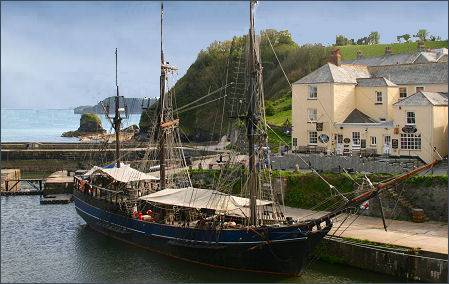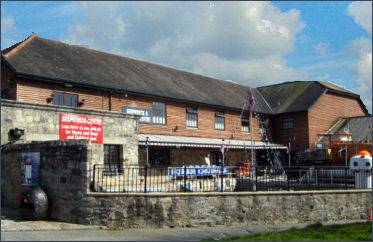Charlestown
OS Grid Ref:- SX 037516
 The picturesque port of Charlestown lies around 2 miles (3 km) to the south east of the town of St Austell on the south east coast of Cornwall.
The picturesque port of Charlestown lies around 2 miles (3 km) to the south east of the town of St Austell on the south east coast of Cornwall.
Charlestown was a Georgian 'new town' which developed from a small fishing village known as West Polmear. West Polmear consisted of a few cottages and three cellars, in which the catch of pilchards were processed. Before the harbour was built trading vessels landed and loaded on the beach.
Local landowner and entrepreneur Charles Rashleigh of Duporth Manor, just outside the village began the construction of a harbour and dock for the export of copper and china clay in 1791.
After building an outer pier, Rashleigh, a member of the influential Rashleigh family of Menabilly, excavated a natural inlet to form the main dock. The first dock gates were completed in 1799. In addition to the port, Rashleigh also planned the village, which featured a broad road running from the harbour to Mount Charles. In 1793, a gun battery was built to the west of the harbour mouth, as a defence against possible French attacks.
 Charlestown Harbour is actually two harbours, inner and outer. The inner harbour has constant water levels and is fed by the original eighteenth century 7 mile system of man-made waterways which ends in two large reservoir ponds situated to the north of the village. From the ponds a system of sluice gates feed the water into the inner harbour when required. The outer harbour is tidal and protected on the west side by a granite mole. The Harbour opens directly into the sea.
Charlestown Harbour is actually two harbours, inner and outer. The inner harbour has constant water levels and is fed by the original eighteenth century 7 mile system of man-made waterways which ends in two large reservoir ponds situated to the north of the village. From the ponds a system of sluice gates feed the water into the inner harbour when required. The outer harbour is tidal and protected on the west side by a granite mole. The Harbour opens directly into the sea.
Charlestown has survived as a working port and a small amount of china clay is still exported. The port remains unspoiled and retains much of its Georgian character. Charlestown harbours a fleet of square riggers ships, there is generally at least one of these superb ships in the harbour.
The village pub, the Rashleigh Arms was built in 1851 on the foundations of old clay cellars . It boasts what is probably one of the only Grade II listed car parks in the country, basically the site of old coal storage yards. The restaurant serves locally sourced food.
Charlestown beach, which lies outside the harbour, is a south-east facing sand and pebble beach, there are a number of small caves in the cliffs. Facilities include a car park, cafés, pubs, restaurants and toilets. Nearby beaches include Porthpean and Duporth, both of which can be reached from Charlestown on foot via the South West Coast Path.
The Shipwreck, Rescue and Heritage Centre
 The Shipwreck, Rescue and Heritage Centre is situated in one of the old China Clay buildings and contains a number of exhibits relating to Charlestown's maritime past along with more general shipwreck salvage from Cornwall's coast.
The Shipwreck, Rescue and Heritage Centre is situated in one of the old China Clay buildings and contains a number of exhibits relating to Charlestown's maritime past along with more general shipwreck salvage from Cornwall's coast.
Visitors to the centre walk through underground tunnels where clay trucks were pushed out to the ships in the port. The Shipwreck and historical artefacts on display in the centre are the largest private collection of this type on public display in Europe.
Brought together over the last 45 to 50 years, it forms the basis of one of the most unusual and interesting collections open to the public. There are countless items from a bygone age as well as artefacts from over 150 shipwrecks.
The many and varied exhibitions reflect life in Charlestown, it's history, shipwrecks and the once thriving China Clay industry. The exhibition shows a tremendous range of maritime history dating back to 1715 and one of the largest underwater diving equipment collections in the country, including various suits used for treasure seeking and naval purposes.